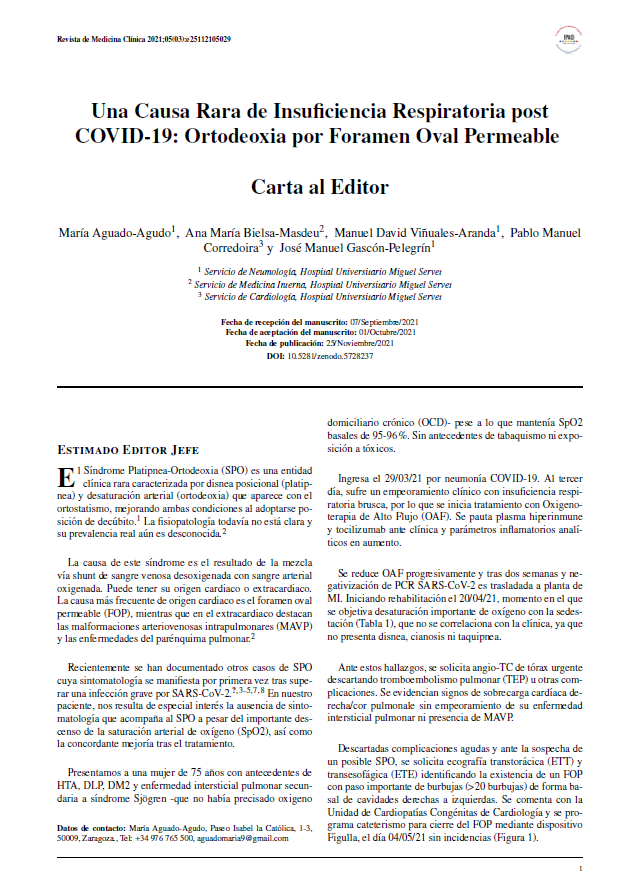Abstract
In relation to the current SARS-CoV-2 pandemic, cases of Platypnea Orthodeoxy Syndrome (SPO) have been documented, the symptoms of which have become apparent once the acute infection by COVID-19 has passed. This syndrome is characterized by positional dyspnea accompanied by significant arterial desaturation to adopt when adopting a standing position, with symptoms remitting when returning to decubitus position. Its pathophysiology is still a mystery, although the most documented cause is cardiac - due to the existence of a patent foramen ovale (PFO) -. We present the case of a patient from our hospital who, after passing the SARS-CoV-2 infection, debuted with SPO and in which the timely diagnosis will improve the cause and restore the patient's previous quality of life.
References
Burchell HB, Helmolz HF Jr, Wood EH. Reflex orthostatic dyspnea associated with pulmonary hypotension. Am J Physiol. 1949; 159:563-4.
Agrawal A, Palkar A, Talwar A. The multiple dimensions of Platypnea-Orthodeoxia syndrome: A review. Respir Med. 2017;129:31–8
Vanhomwegen C, Taton O, Selvais N, Vanhove O, Leduc D. Patent foramen ovale revealed by COVID-19 pneumonia. BMC Pulm Med. 2021;21(1):1–4.
Longo C, Ruffini L, Zanoni N, Longo F, Accogli R, Graziani T, et al. Platypnea-orthodeoxia after fibrotic evolution of SARS-CoV-2 interstitial pneumonia. A case report. Acta Biomed. 2020;91(3):1–7.
Tan GP, Ho S, Fan BE, Chotirmall SH, Tan CH, Lew SJW, Chia PY, Young BE, Abisheganaden JA, Puah SH. Reversible platypnea-orthodeoxia in COVID-19 acute respiratory distress syndrome survivors. Respir Physiol Neurobiol. 2020 Nov;282:103515
Singh K, Kadnur H, Ray A, Khanna P, Singh A, Wig N, et al. Platypnea-orthodeoxia in a patient with severe COVID-19 pneumonia. Monaldi Arch Chest Dis. 2020;90(4):718–20.
Corrêa PC. On the case report of platypnea-orthodeoxia after SARSCoV-2 pneumonia plus historical notes. Acta Biomed. 2020;91(4):1–2.
Tham S, Ong P, Lee A, Tay M. Rehabilitation of patients with platypnea-orthodeoxia syndrome in COVID-19 pneumonia: Two case reports. J Rehabil Med – Clin Commun. 2020;3(1):1-5.
Yepes I, Ji S, Wu F, Tijmes S, Roberts J. Platypnea-Orthodeoxia Syndrome: Rare or Under-Diagnosed Syndrome? 3 Case Reports and a Literature Review. Cardiovasc Revascularization Med. 2021;22(xxxx):115–9.
Layoun ME, Aboulhosn JA, Tobis JM. Potential role of patent foramen ovale in exacerbating hypoxemia: In chronic pulmonary disease. Texas Hear Inst J. 2017;44(3):189–97.
Sabater Abad C, Juan Samper G, Payá Serrano R, Pérez Boscá JL, Ramón Capilla M, Fernandez Fabrellas E. Síndrome platipnea-ortodeoxia cardiaco: una causa «misteriosa» de hipoxemia. Archivos de Bronconeumología. 2016;52(9):494-5.
Cheng TO. Mechnisms of platypnea-orthodeoxia: What causes water to flowuphill? Circulation. 2002;105:e47.
Tarrasó Castillo J, Posadas Blázquez TJ, Lahosa Córdoba C, Signes-Costa J. COVID-19: New disease, new manifestations. Arch Bronconeumol. 2020 Dec;56(12):825-26
Calvert PA, Rana BS, Kydd AC, Shapiro LM. Patent foramen ovale: Anatomy, outcomes, and closure. Nat Rev Cardiol. 2011;8(3):148–60.
Siswanto, Gani M, Fauzi AR, Yuliyanti RE, Inggriani MP, Nugroho B, et al. Possible silent hypoxemia in a COVID-19 patient: A case report. Ann Med Surg. 2020;60(October):583–6.
Tobin MJ, Laghi F, Jubran A. Why COVID-19 Silent Hypoxemia Is Baffling to Physicians. Am J Respir Crit Care Med. 2020;202(3):356-60
Brito-Azevedo A, Pinto EC, de Cata Preta Corrêa GA, Bouskela E. SARS-CoV-2 infection causes pulmonary shunt by vasodilatation. J Med Virol. 2021;93(1):573–5.
Salazar C, Blank JB, Palmero V. Orthodeoxia without Platypnea in Hereditary Hemorrhagic Telangiectasia in the Presence of a Cerebral Abscess and Multiple Pulmonary Arteriovenous Malformations: Unusual Complications and Transcatheter Endovascular Treatment. Case Rep Pulmonol. 2017;2017:1–4.
Santhirapala V, Chamali B, McKernan H, Tighe HC, Williams LC, Springett JT, et al. Orthodeoxia and postural orthostatic tachycardia in patients with pulmonary arteriovenous malformations: A prospective 8-year series. Thorax. 2014;69(11):1046–7.
Santhirapala V, Williams LC, Tighe HC, Jackson JE, Shovlin CL. Arterial oxygen content is precisely maintained by graded erythrocytotic responses in settings of high/normal serum iron levels, and predicts exercise capacity: An observational study of hypoxaemic patients with pulmonary arteriovenous malformations. PLoS One. 2014;9(3):1–11.

This work is licensed under a Creative Commons Attribution-NonCommercial-NoDerivatives 4.0 International License.
Copyright (c) 2021 Revista de Medicina Clínica

